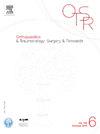利用机器学习算法预测女性患者双侧原发性全膝关节置换术后的步速变化
IF 2.3
3区 医学
Q2 ORTHOPEDICS
引用次数: 0
摘要
背景全膝关节置换术的一个重要目的是实现功能恢复,其中包括术后步行速度的提高。因此,预测患者术后行走速度是快还是慢对于 TKA 来说非常重要,而之前的文献对此还没有进行过研究。哪些患者在 TKA 术后行走速度更快,哪些患者行走速度更慢?在这项回顾性队列研究中,128 名接受分期双侧全膝关节置换术的女性患者在术前和术后两年接受了步态分析。根据全膝关节置换术后步速变化的百分比,这些患者被分为三个不同的组别:1)V(+)组,步速增加超过 10%;2)V(-)组,步速减少超过 10%;3)V(0)组,介于两者之间。对两组(V(+)和 V(-))的步态参数、机械轴角度、WOMAC 疼痛评分和膝关节协会评分进行了比较。结果全膝关节置换术后,平均步速增加了 0.07 米/秒,从 0.87 米/秒增至 0.94 米/秒(p < 0.001),43.8% 的患者(n = 56)步速增加。然而,相当多的患者(n = 17,13.3%)步速下降。将V(+)组和V(-)组进行比较,发现V(+)组的步速、步幅、膝关节矢状/冠状运动范围和膝关节社会功能评分在术前较低,但在术后有所提高。步速变化可通过三个变量(术前步速、年龄和机械轴角的大小)进行预测。机器学习模型的接收器操作特征曲线下面积为 0.86。然而,相当一部分患者的步速有所下降。机器学习分类模型显示出良好的预测性能,有助于全膝关节置换术的决策和时机选择。本文章由计算机程序翻译,如有差异,请以英文原文为准。
Prediction of postoperative gait speed change after bilateral primary total knee arthroplasty in female patients using a machine learning algorithm
Background
An important aim of total knee arthroplasty is to achieve functional recovery, which includes post-operative increase in walking speed. Therefore, predicting whether a patient will walk faster or slower after surgery is important in TKA, which has not been studied in previous literatures. Who walks faster and who walks slower after TKA? Can we predict these kinds of patients before surgery?
Hypothesis
Whether or not a patient walk faster after total knee arthroplasty can be predicted with preoperative characteristics.
Patients and methods
In this retrospective cohort study, 128 female patients who underwent staged bilateral total knee arthroplasty were analyzed with gait analysis preoperatively and at postoperative two years. These patients were divided into three different groups according to the percentage of gait speed change after total knee arthroplasty: 1) V(+), more than 10% gait speed increase; 2) V(−), more than 10% gait speed decrease; and 3) V(0), those in-between. Gait parameters, mechanical axis angles, WOMAC pain score and Knee Society scores of the two groups (V(+) and V(−)) were compared. Furthermore, a classification model predicting whether a patient walks faster after total knee arthroplasty was designed using a machine learning algorithm.
Results
After total knee arthroplasty, average gait speed increased by 0.07 m/s from 0.87 m/s to 0.94 m/s (p < 0.001) and gait speed increased in 43.8% of the patients (n = 56). However, gait speed decreased in a significant number of patients (n = 17, 13.3%). When V(+) and V(−) groups were compared, gait speed, cadence, sagittal/coronal knee range of motion, and Knee Society Function score were lower in the V(+) group before surgery, but became higher after surgery. Gait speed change could be predicted using three variables (preoperative gait speed, age, and the magnitude of mechanical axis angle). The area under the receiver operating characteristic curve of the machine learning model was 0.86.
Discussion
After total knee arthroplasty, gait speed was maintained or increased in most patients. However, gait speed decreased in a significant number of patients. The machine learning classification model showed a good predictive performance, which could aid in the decision-making and the timing of total knee arthroplasty.
Level of evidence
III; retrospective cohort study.
求助全文
通过发布文献求助,成功后即可免费获取论文全文。
去求助
来源期刊
CiteScore
5.10
自引率
26.10%
发文量
329
审稿时长
12.5 weeks
期刊介绍:
Orthopaedics & Traumatology: Surgery & Research (OTSR) publishes original scientific work in English related to all domains of orthopaedics. Original articles, Reviews, Technical notes and Concise follow-up of a former OTSR study are published in English in electronic form only and indexed in the main international databases.

 求助内容:
求助内容: 应助结果提醒方式:
应助结果提醒方式:


